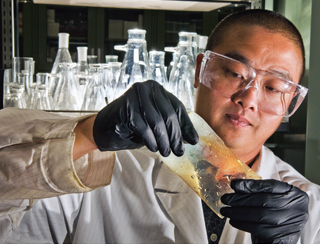
Sandia researcher Cy Fujimoto (6338) may hold one of the keys to making hydrogen hybrid cars a commercially viable transportation option. It’s a new type of hydrocarbon polymer electrolyte membrane (PEM) he invented that shows great promise in being as durable and able to perform as well as current commercial state-of-the-art PEM materials made out of perfluoronated polymers.
A proton exchange membrane fuel cell converts chemical energy into electrical energy. In the case of a hydrogen fuel cell, hydrogen and oxygen are converted to water and produce electricity and waste heat.
“What is interesting is that while most hydrocarbon membranes are significantly cheaper to produce and manufacture than perfluoronated polymers, they do not typically last as long or perform as well as perfluoronated membranes under dry conditions. Our current hydrocarbon membrane appears to do both,” Cy says.
The lack of reliable PEMs that work well in both dry and humid environments has been one of the impediments to hydrogen hybrid cars reaching the marketplace.
“The findings have been quite intriguing and may impact the future of hydrogen cars,” Cy says as he reflects on recent tests where the Sandia polymer outperformed in two categories those made by manufacturers of current state-of-the-art fuel cells for automotive use.
The new PEM hydrocarbon material evolved from an earlier generation Cy and former Sandian Chris Cornelius developed five years ago that operate at elevated temperatures. The early Sandia fuel cell material, however, was not specifically designed for automotive applications. Cy is making adjustments so that it will fit automakers’ needs, which include high proton conductivity at high temperature and at low water contents.
Cy anticipates that the new materials he developed over the past year and a half will make the Sandia PEM perform better at low relative humidity. The chemistry allows him to control where and how much acid is deposited on the polymer backbone, which enables fine-tuning of the size of ion conducting channels. With larger pathways for proton movement the membranes will work better in low humidity environments.
Current acid-containing perfluoronated polymers, such as Nafion, maintain a path for protons to pass through when the membranes are hydrated. As they dehydrate, the path shrinks and becomes disconnected, restricting proton movement. The result is diminished function of fuel cells in dry desert climates like the Southwest.
Cy compares the current state of PEMs to a path in a park.
“You can be moving right along and then come to a place where the path breaks. A person walking the path can maneuver around the break and move on. Not so with protons. They come to a dead end,” he says. “Automobile manufacturers want a membrane that is reliable in all environments. They can’t have one that functions well in a humid climate like Miami, for example, and not work well in dry Albuquerque.”
Working through Sandia’s Intellectual Project Management, Alliances & Licensing Dept. 1031, Cy is collaborating with a consortium of automobile manufacturers to build the better PEM. He says a cooperative research and development agreement (CRADA) and possible licensing of the technology are forthcoming.
Before the collaboration can proceed much further, he says, he needs to come up with a way to “scale up the chemistry” so the membrane can be mass-produced at a low cost.
“We have to get the cost of manufacturing the membrane below $25 per square meter for the method to be practical for cars,” Cy says. “This is one of the biggest challenges.”
Licensing Dept. working more closely with SMUs
Cy Fujimoto’s (6338) membrane project is one of the first projects of a new and improved Project Management, Alliances & Licensing Dept. 1031, says department manager Mark Allen.
When he became manager about six months ago, Mark says, he wanted to try something different to make the department work more efficiently. He came up with the idea of assigning each of his six licensing executives the responsibility for specific SMUs. The licensing agents serve as a link between the SMUs, research foundations, lawyers, and potential partners.
“Historically the line people came to us with ideas for licensing and tech transfer,” Mark says. “Now we are being more proactive, seeking out candidate research. We are more engaged in working with senior managers and people are eager and excited about the prospect of their inventions receiving patents and being licensed. We hope this makes for a better method of getting our research commercialized.”